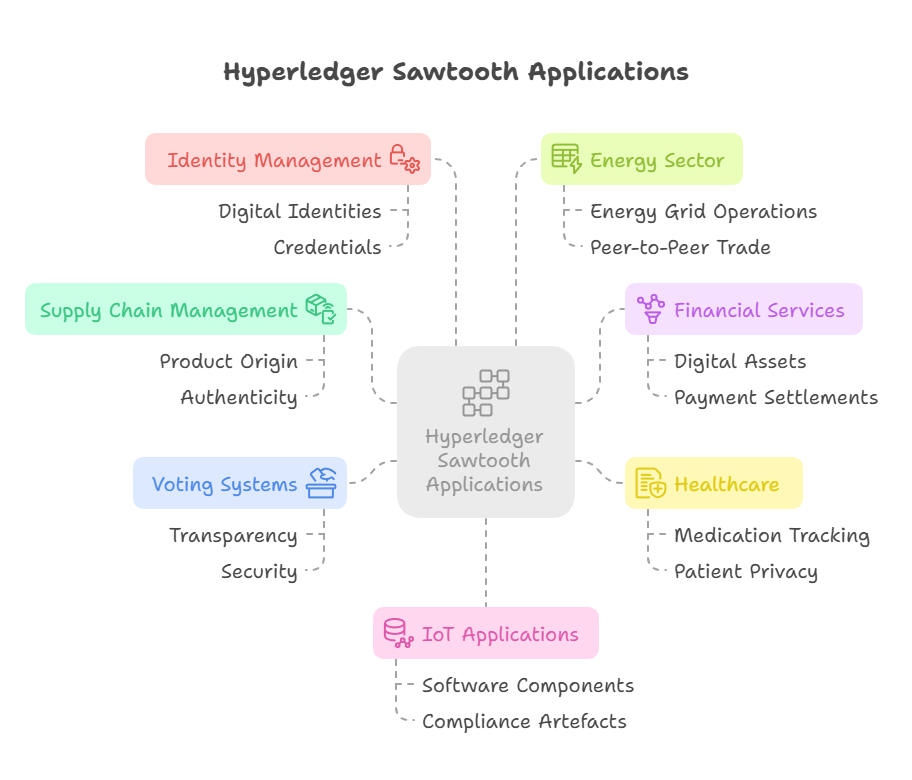What is Hyperledger Sawtooth

What is Hyperledger Sawtooth
The open-source Hyperledger Sawtooth blockchain architecture and enterprise-level BaaS platform simplify distributed ledger application creation, implementation, and management. The Linux Foundation’s Hyperledger project promotes blockchain technologies across industries.
A thorough description of Hyperledger Sawtooth may be found here:
Core Purpose and Design
In order to ensure that ledgers stay dispersed and smart contracts are safe in a business setting, Sawtooth was created especially to assist organisations in creating and administering distributed ledger networks and applications. Making Smart Contract execution safe is a major objective, as it is essential for enterprise applications. It provides a modular design that isolates a blockchain’s essential operations from its business logic, allowing it to be flexible and adjusted to a range of use cases. System security is preserved while application development is made easier by this division.
You can also read What Is Mean By SDK Blockchain And Hyperledger Fabric API?
Key Features
- Separation of Concerns: Sawtooth permits customization and extension by separating the application logic from the essential blockchain behaviour. Transaction rules, permissions, and consensus settings are managed under the Transaction Processing section, which allows developers to construct their models according to business requirements.
- Flexibility: Because of its modular architecture, different parts and transaction processors that are suited to certain requirements can be integrated.
- Developers can specify the validation and application of transactions by creating custom transaction processors. Encapsulating the business logic are these processors.
- Block leaders are chosen by a lottery using Sawtooth’s default consensus process, Proof of Elapsed Time (PoET). Its scalable, resilient, and energy-efficient design adds public blockchain resilience to the enterprise space.
- Global State: By guaranteeing that every transaction updates the state in unison, Sawtooth keeps the blockchain’s global state constant. This status is validated and managed effectively.
- High Throughput: Large-scale deployments and high transaction volumes are supported by its design.
- Sawtooth eliminates the serial execution bottleneck present in many cryptocurrency networks and speeds up block formation and validation by Parallel Transaction Execution. This improves operating performance.
- Python, JavaScript, Go, Rust, C++, and Java are client/server languages. These Multi-Language Support build transaction processors and interface with ledgers.
- Dynamic Consensus: As new, more scalable algorithms are developed, administrators can gradually alter the consensus process.
- Sawtooth focusses on permissioned networks, which are networks with known and authorised participants for business-to-business and enterprise settings. By installing groups of nodes with varying permissions on the same blockchain, it permits selective permissions.
- Immutable Transaction History: Its cryptographic connection between transactions ensures data accuracy and log auditability.
- A few nodes can crash or go offline, but the network can continue. Byzantine Fault Tolerance lets it functioning even if one-third of the nodes are interrupting the network.
Core Components
The main Sawtooth blockchain node components are as follows:
- Transaction Processor: Manages the business logic of transactions, applied to the blockchain state, and validated.
- With support for pluggable algorithms, the consensus engine oversees consensus over the validity and order of transactions throughout the network.
- Blockchain: The central ledger with permanently recorded transactions.
- Validators are network nodes that propose blocks, verify transactions, and enforce consensus.
- Developers can submit transactions and inspect the blockchain using Sawtooth’s REST API HTTP endpoints.
- A client SDK: Software development tools for Python, JavaScript, Java, Go, and C++ simplify Sawtooth network interaction.
- The transaction family defines state handlers and transaction processor functionality.
- State Database: Usually made with Apache Cassandra or RocksDB, this database keeps track of the blockchain’s current state.
- Sawtooth Runtime: Controls how transactions are carried out and preserves the global state.
- Network configurations and settings are managed using the configuration system, which permits dynamic modifications.
- Data for transaction families is stored in the Global State using an accessible Radix Merkle tree.
- Block Completer, Block Validator, and Chain Controller all collaborate to generate and verify blocks in the journal.
- Transaction Scheduler: Chooses which transactions to execute and tracks dependencies using a tree structure.
- Transaction Executor: Chooses a transaction to be executed for block production or validation by calling the scheduler.
How Hyperledger Sawtooth Works
The procedure usually consists of the following steps:
- Network Setup: A consensus algorithm is agreed upon by nodes (validators) to build a network.
- Transaction Submission: Clients create, sign (using their private key), and send batches and transactions to the network using REST APIs or Client SDKs.
- Transaction Processing: Using the REST API, batches are sent to validators. The transaction family defines the specific logic used by each node’s transaction processor to handle validation and execution.
- Scheduling and Execution: The block publisher gives batches to the scheduler, which then submits transactions to the executor. The executor provides the transaction and its context to the transaction processor.
- Validation: The transaction processor uses its business logic to verify the transaction. Validators check blocks and transactions for consensus compliance.
- Consensus Mechanism: Validators submit new blocks, aggregate and validate transactions, then determine that the proposed block is correct using the picked method (such PoET). The consensus mechanism verifies a block before adding it to the chain.
- State Management: Once consensus is reached, the block is committed to the blockchain, and the transactions within it are applied to the global state, updating the state database.
- Block and State Storage: Blocks are added to the blockchain in a chain, ensuring immutability, while the state is stored in a database for efficient access.
You can also read What Is An Equity Token Offering (ETO), IEO And DAICO?
Supported Consensus Algorithms
Because of Sawtooth’s modular architecture, pluggable consensus techniques are possible:
- Using trusted execution environments (TEEs) for equitable and effective consensus based on randomized waiting durations, PoET (Proof of Elapsed Time) is the default algorithm.
- Practical Byzantine Fault Tolerance, or PBFT, is made to withstand Byzantine faults, which are malevolent or randomly failing nodes. It ensures robust consistency and can tolerate up to one-third of defective nodes.
- Raft is a consensus technique that handles node failures gracefully by choosing new leaders and copying logs, providing great consistency and fault tolerance in distributed systems.
- A Raft consensus method implementation designed especially for Hyperledger Sawtooth, Sawtooth Lake offers effective block generation.
Security Features
Several security mechanisms are incorporated with Sawtooth:
- Identity Verification: Each node is given a unique identity, and participants are authenticated and authorised using digital certificates and cryptographic keys.
- Access Control: Manages permissions and roles based on identities for fine-grained control over actions and data access.
- Custom Logic: Transaction processors can include custom validation logic, ensuring adherence to business rules.
- Fault Tolerance: Resilience against malicious conduct or node failures is offered by consensus techniques such as PBFT and Raft.
- Both logging and monitoring are included to keep track of transaction processing and state changes for audit trails. Monitoring tools can be used to watch network activity and spot irregularities.
- Security Patches: To fix vulnerabilities in the program, the project actively maintains and upgrades it.
Applications

Hyperledger Sawtooth Applications
There are several industries where Hyperledger Sawtooth can be used:
- Supply Chain Management: Monitoring the origin of products for responsibility, visibility, and authenticity.
- Financial Services: Managing digital assets (cryptocurrencies, tokenized assets) and streamlining processes like letters of credit, invoicing, and payment settlements.
- Healthcare: Safely keeping track of medications, protecting patient privacy, and managing and archiving medical data.
- Voting Systems: Offering transparent and safe electronic voting.
- Managing digital identities and credentials to increase security and reduce fraud is identity management.
- Energy Sector: Improving energy grid operations and peer-to-peer trade.
- IoT Applications: It is appropriate for IoT applications, including managing software parts ledgers to manage components, compliance artefacts, and crypto data in intricate software systems, to its capabilities, especially PoET.
Connectivity with Other Technologies
The modular design of Sawtooth makes integration easier:
- Databases and Storage Systems: Capable of supporting multiple databases, such as RocksDB and Apache Cassandra, for storing blockchain state.
- Custom identity management solutions can be integrated with identity management systems to improve authentication and security.
- Client SDKs and RESTful APIs are offered by web and application frameworks to facilitate integration with web apps and services.
- Cloud Platforms and DevOps Tools: Deployable on cloud platforms (AWS, Azure, Google Cloud) and integrates with DevOps tools using container technologies like Docker.
Challenges and Limitations
- Customisation Complexity: Deep expertise is needed to customise elements such as consensus algorithms and transaction families.
- Scalability: Complex transaction families and large networks require careful tailoring to get optimal performance at scale.
- Testing and validation: Custom transaction processors must be tested to ensure correctness and security to avoid vulnerabilities.
- Data Protection: from Sybil and DDoS assaults requires ongoing attention to detail and strong security measures.
- Interoperability: Integrating with existing enterprise systems may require custom adapters and significant development effort.
- Multi-Component Setup: Its modular design may need complex setup and configuration.
- Consensus Overhead: A considerable amount of communication and processing resources may be expended by certain consensus algorithms, such as PBFT.
- Data Migration: Exiting traditional systems is challenging.
- Node Management: Dispersed networks make updates, failures, and node health management challenging.
Project status
For read-only storage, owner archived Hyperledger Sawtooth on February 1, 2024. The Splinter community now maintains the project.
You can also read Ganache Workspace Explained: Setting Up Your Ethereum
